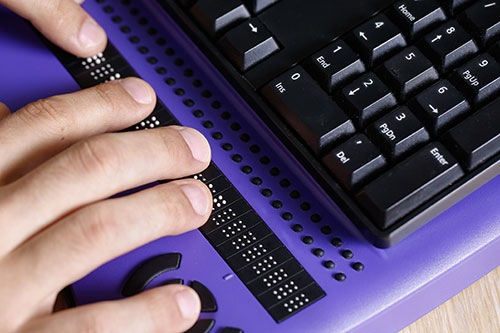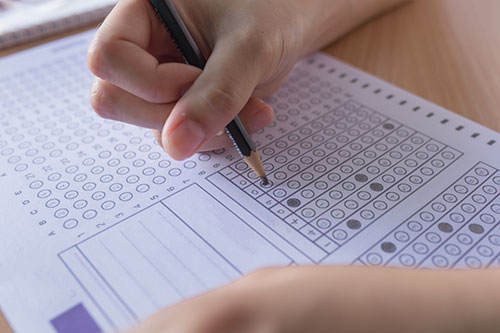What are the teacher’s responsibilities for students with disabilities who use accommodations?
Page 9: Implementing an Accommodation
 As covered on a previous page, teachers are required to provide instructional or testing accommodations documented on a student’s individualized education program (IEP) or 504 plan. For some students, accommodations may be needed for just one or two classes; for others, they might be needed in every class. By reviewing the student’s IEP or 504 plan, teachers can identify the accommodations and the context in which they should be implemented. As you will see below, there are a number of steps that teachers can take to ensure that students receive the maximum benefit from their required accommodations.
As covered on a previous page, teachers are required to provide instructional or testing accommodations documented on a student’s individualized education program (IEP) or 504 plan. For some students, accommodations may be needed for just one or two classes; for others, they might be needed in every class. By reviewing the student’s IEP or 504 plan, teachers can identify the accommodations and the context in which they should be implemented. As you will see below, there are a number of steps that teachers can take to ensure that students receive the maximum benefit from their required accommodations.
 Review the student’s IEP or 504 plan.
Review the student’s IEP or 504 plan.- Know the student’s strengths and weaknesses.
- Recognize that, though some accommodations will be simple to implement in the classroom, others will be more difficult or might require more time to learn to use effectively.
- Allow students time to practice using new accommodations to become proficient. Start with familiar content so they are not struggling to learn new information at the same time they are learning to use new accommodations.
- Be aware that students using accommodations might require more or less time to complete instructional tasks.
- Recognize that changing demands throughout the school day might mean that a student’s accommodations differ from one class setting to the next.
- Understand how the classroom environment can affect the student’s successful use of his or her accommodations.
- Be aware of how the student perceives the recommended accommodations (e.g., does your student think his accommodation is useful, embarrassing?).
- Monitor the student’s progress regularly because needs can change over time.
 Learn about each student’s equipment needs (e.g., software, devices).
Learn about each student’s equipment needs (e.g., software, devices).- Create seating arrangements that support the use of devices without excluding the student from the class. The proper use of many devices requires proximity to an electrical outlet or additional space. However, students should not be isolated—for example, in the back of the classroom—solely for the purpose of accessing an outlet.
- Set aside space for equipment when it is not in use. Placing the equipment in a safe location protects it from damage.
- Be sure the audio option is enabled on computers for students who use the synthesized voice feature. Computers in classrooms, libraries, or labs often have their audio options disabled to reduce noise and distractions. To prevent disrupting other students, provide headphones.
- Be sure the settings on the computer or text reader (e.g., font size, boldface, speed of braille refreshable text) match the needs of the student. Failing to pre-set these can waste valuable classroom time. Also, teach students to personalize their settings independently so that they are prepared to do this in other environments.
- Obtain appropriate devices or services (e.g., USB drives, cloud storage) for saving and transporting data files. Students may need to access the files away from the classroom or on different equipment (e.g., a personal laptop).
 Attend trainings about accommodations to understand specific policies and guidelines for your state (e.g., guidelines for testing accommodations).
Attend trainings about accommodations to understand specific policies and guidelines for your state (e.g., guidelines for testing accommodations).- Collaborate and communicate with knowledgeable individuals (e.g., special education teachers, parents, students).
- Read professional journals.
- Visit reputable websites:
- Federally funded centers (e.g., National Center for Educational Outcomes)
- Advocacy groups (e.g., National Center for Learning Disabilities)
 Provide only the testing accommodations listed on the student’s IEP or 504 plan and that are allowed for that particular test.
Provide only the testing accommodations listed on the student’s IEP or 504 plan and that are allowed for that particular test.- Understand that an accommodation might be permissible in one condition but not in another (e.g., a text reader can be used during a comprehension test but not during a test that measures decoding skills).
- Allow opportunities for students to become familiar with an accommodation before having to use it in a testing situation. In fact, some states require that testing accommodations be made available to the student for a specified amount of time prior to the day of testing.
- Be aware that an accommodation might be allowed for a classroom assessment but not for a standardized assessment.
- Be familiar with the assessment accommodations allowed in your state for standardized tests. Each state has policies and regulations that determine allowable accommodations according to the standardized test being administered.
With careful planning and consideration, teachers can provide accommodations to their students effectively and efficiently. Implementing accommodations requires thoughtfulness and planning to meet the needs of individual students. Therefore, teachers should avoid:
- Providing the same accommodation to all students with disabilities out of convenience
- Disregarding an accommodation because only one or a few students need it or because it is difficult to implement
- Believing that only the special education teacher provides accommodations
For Your Information
Because most students with disabilities participate in the general education curriculum for a majority of the day, general education teachers will be responsible for implementing accommodations. Teachers should recognize that they are not on their own. For support, they can reach out to others with expertise (e.g., special education teacher, special education coordinator, assistive technology specialist).
Through the use of individualized accommodations, students with disabilities are more likely to successfully access and demonstrate learning. There are instances, however, when students continue to struggle even with the accommodations in place, or they begin to struggle in a new area. When either occurs, the teacher might want to try a new accommodation. If the teacher identifies a beneficial accommodation, the IEP team should convene to determine whether it should be added to the student’s IEP.
Keep in Mind
Teachers can bundle accommodations within the same category (e.g., two presentation accommodations) or from different categories (e.g., presentation and setting accommodations) to meet a student’s needs. Starting with one accommodation will allow the teacher to evaluate its effectiveness and determine whether it is practical for use in the classroom before implementing a second.